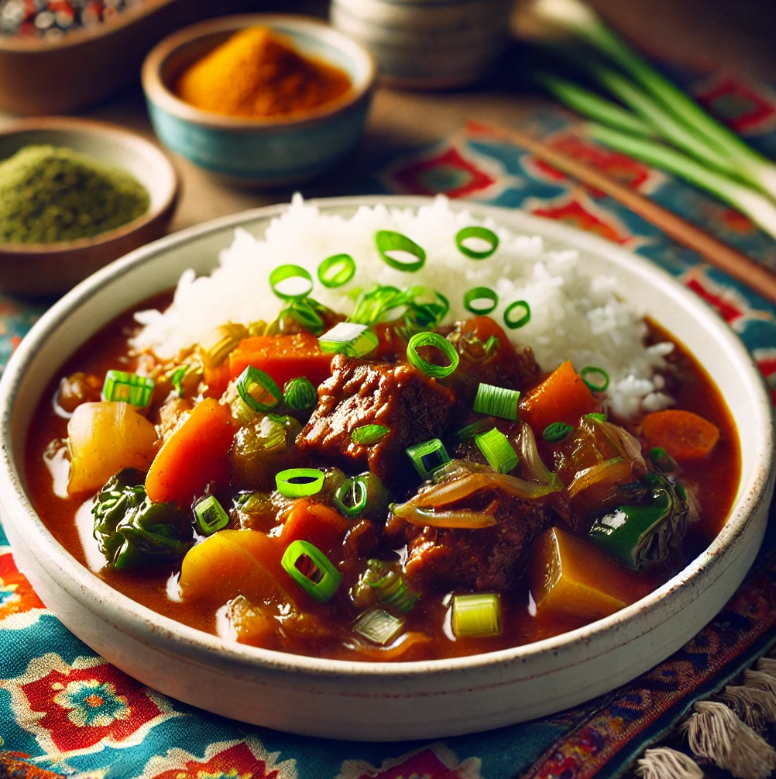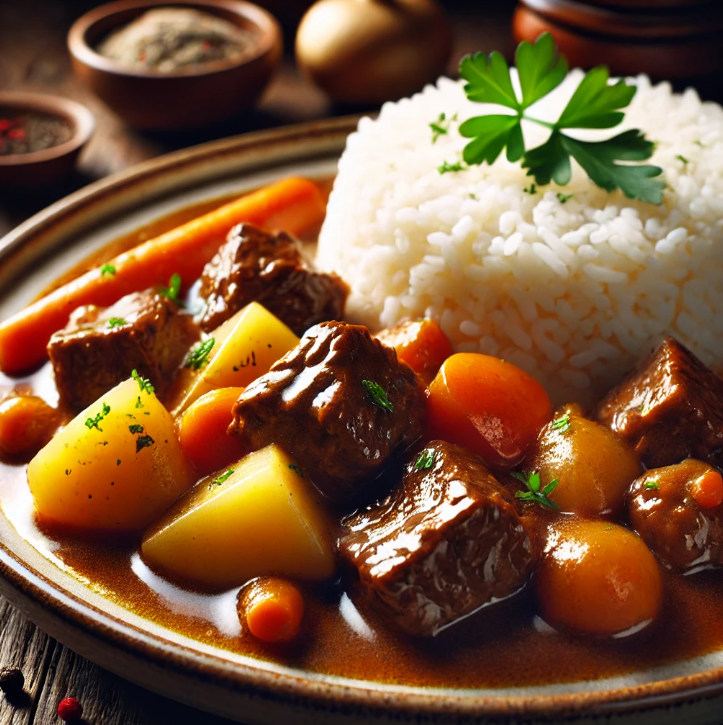There’s something undeniably satisfying about beef stew and rice. It’s a hearty, flavorful dish that combines tender chunks of beef with a savory, rich stew, served over fluffy rice. This classic meal brings warmth and comfort to the table, making it a favorite in many households worldwide.
In this article, we’ll take a deep dive into the world of beef stew and rice, exploring everything from essential ingredients and preparation techniques to variations and nutritional benefits. Whether you’re a seasoned cook or a beginner looking to impress your family, this guide will equip you with all the tips and tricks you need to master this timeless dish.
Table of Contents
Introduction to Beef Stew and Rice
What Is Beef Stew and Rice?
Beef stew and rice is a combination of two comforting staples: a slow-cooked, flavorful beef stew served alongside or over a bed of steamed rice. The stew typically features tender beef chunks, a medley of vegetables, and a rich, savory broth seasoned with herbs and spices. The rice soaks up the delicious sauce, making every bite a perfect balance of textures and flavors.
Why It’s a Popular Comfort Food
This dish has universal appeal because it’s hearty, filling, and adaptable to various tastes. It’s a go-to meal for busy weeknights and special occasions alike. The beef stew provides a warm, nourishing base, while the rice adds a satisfying, starchy complement. Together, they create a complete meal that’s easy to make and even easier to love.
The Appeal of Combining Stew with Rice
Pairing beef stew with rice enhances the dish’s versatility. The rice acts as a neutral backdrop, allowing the bold flavors of the stew to shine. Plus, it stretches the meal further, making it an economical choice for feeding a crowd. Whether you prefer white rice, brown rice, or fragrant jasmine, the combination is a guaranteed crowd-pleaser.
Ingredients for Beef Stew and Rice
Core Ingredients for a Classic Beef Stew
Creating the perfect beef stew and rice begins with the right ingredients. Start with a hearty cut of beef, such as chuck roast or stew meat, known for its ability to become tender when slow-cooked. Vegetables like carrots, celery, and onions provide sweetness and texture, while garlic adds a punch of savory flavor.
For the stew’s base, a combination of beef broth and crushed tomatoes creates a rich, flavorful sauce. To elevate the dish, season with classic spices like bay leaves, thyme, paprika, and black pepper. Adding a splash of red wine or balsamic vinegar can deepen the flavor profile, making the stew even more robust.
Choosing the Right Rice
Rice plays a crucial role in balancing the dish. For a traditional pairing, use white rice, which absorbs the flavors of the stew beautifully. If you’re looking for a nuttier taste and added nutrition, opt for brown rice. Jasmine or basmati rice can add a fragrant touch, while wild rice brings a slightly chewy texture that complements the tender beef.
Cooking the rice separately allows it to remain fluffy and prevents it from becoming soggy when served with the stew. This way, each grain retains its texture while soaking up the stew’s rich sauce.
Preparing the Beef for the Stew
Selecting the Best Beef Cuts
For a flavorful beef stew and rice, choosing the right cut of beef is essential. Look for cuts with marbling, such as chuck roast, brisket, or bottom round. These cuts break down beautifully during slow cooking, resulting in tender, melt-in-your-mouth pieces of meat.
When preparing the beef, trim any excess fat and cut it into bite-sized cubes for even cooking. This step ensures every piece cooks uniformly, creating a stew with consistent texture.
Searing the Meat for Maximum Flavor
Searing the beef before simmering is a step you don’t want to skip. Browning the meat caramelizes its surface, locking in juices and adding depth to the stew’s flavor. To do this, heat a heavy-bottomed pot or Dutch oven over medium-high heat with a bit of oil.
Add the beef cubes in small batches, ensuring they don’t overcrowd the pan. Cook until each side is golden brown, then remove the beef and set it aside. This process also leaves flavorful bits, or “fond,” at the bottom of the pot, which will enhance the stew when you deglaze it with broth or wine.
Cooking the Beef Stew
Stovetop Method for Beef Stew
Making beef stew and rice on the stovetop is a classic approach that allows the flavors to meld beautifully. Start by searing the beef in a large pot until it’s browned on all sides, then remove it and set it aside. In the same pot, sauté onions, carrots, and celery until softened, then add garlic for a burst of aroma.
Next, stir in beef broth, diced tomatoes, and your choice of seasonings like bay leaves, thyme, and smoked paprika. Return the beef to the pot, reduce the heat, and let the stew simmer gently for 1.5 to 2 hours. Stir occasionally and add vegetables like potatoes and zucchini during the last 30 minutes of cooking to keep them tender but not mushy.
This method creates a rich, hearty stew that pairs perfectly with fluffy rice.
Slow Cooker and Pressure Cooker Alternatives
If you prefer a hands-off method, a slow cooker or pressure cooker is ideal. For a slow cooker, layer the seared beef with vegetables and broth, then cook on low for 6-8 hours or high for 4-5 hours. The extended cooking time ensures the meat becomes fork-tender and the flavors deepen.
A pressure cooker, such as an Instant Pot, is great for faster results. Use the sauté function to sear the beef and soften the vegetables. Add the liquids and seasonings, then cook on high pressure for 35-40 minutes. Let the pressure release naturally for 10 minutes before opening the lid.
You can also check out creamy chicken and rice for an alternative protein-packed option here.
Cooking Perfect Rice for Beef Stew
Choosing the Right Cooking Method
The rice in beef stew and rice should complement the stew without overpowering it. Cooking rice on the stovetop is straightforward—combine rice with water or broth in a 1:2 ratio, bring to a boil, cover, and simmer until the liquid is absorbed. For a hands-off approach, a rice cooker guarantees perfectly cooked rice every time.
An Instant Pot is another excellent option, especially if you’re short on time. Use the pressure cooker setting and cook rice on high for 3-4 minutes, followed by a natural release.
Seasoning the Rice
To enhance the dish, consider seasoning the rice while it cooks. Replace some of the water with beef or chicken broth for added flavor. Adding a bay leaf, garlic cloves, or a pinch of saffron can elevate the taste further.
Once cooked, fluff the rice with a fork to keep it light and airy. Serve it alongside or beneath the beef stew, allowing the rice to absorb the stew’s rich sauce for a perfect harmony of flavors.
For side dishes to complement this meal, consider fried cabbage and sausage for a hearty pairing. Learn more about this option here.
FAQs About Beef Stew and Rice
What Makes Beef Stew and Rice Unique?
Beef stew and rice stands out for its versatility and comforting qualities. While the stew itself is rich and hearty, the addition of rice creates a balanced meal that satisfies on multiple levels. The rice absorbs the stew’s flavors, ensuring each bite is packed with savory goodness. This combination makes it both a practical and indulgent choice for family meals or gatherings.
Can I Use Pre-Cooked Beef for Stew?
Yes, pre-cooked beef can be used to save time, but there are a few things to keep in mind. Add the pre-cooked beef toward the end of the cooking process to prevent it from becoming tough or dry. While it may lack the depth of flavor from searing raw beef, incorporating flavorful spices and broth can compensate.
What Are Good Substitutes for Rice?
If rice isn’t your preference, there are plenty of alternatives. Quinoa, couscous, or mashed potatoes work well as substitutes. For a lower-carb option, try serving the stew with cauliflower rice or roasted vegetables.
How Do I Store and Reheat Beef Stew and Rice?
Store leftovers in airtight containers in the refrigerator for up to 3 days. When reheating, use the stovetop or microwave and add a splash of broth to maintain the stew’s consistency. Rice can be reheated separately to avoid becoming overly soft.
Nutritional Benefits of Beef Stew and Rice
Macronutrients in Beef Stew and Rice
A bowl of beef stew and rice provides a well-rounded combination of protein, carbohydrates, and healthy fats. The beef is a great source of protein, essential for muscle repair and growth, while rice offers energy-boosting carbs. Depending on the type of rice and vegetables used, the dish can also provide fiber and essential vitamins.
How Vegetables and Spices Boost Nutritional Value
The vegetables in beef stew and rice aren’t just for flavor—they’re packed with nutrients too. Carrots contribute vitamin A for eye health, while celery and onions provide antioxidants and vitamins that support the immune system. Adding garlic and spices like turmeric or paprika not only enhances flavor but also introduces anti-inflammatory and metabolism-boosting benefits.
For a lighter version of the dish, opt for leaner cuts of beef and brown rice, which adds fiber and essential minerals. With the right balance of ingredients, beef stew and rice can be both nourishing and delicious, making it a smart choice for any meal.
Variations and Regional Twists on Beef Stew and Rice
International Variations
Beef stew and rice is a universal dish with many cultural adaptations. In the Caribbean, dishes like Jamaican oxtail stew served over rice and peas bring a spicy, savory twist to the classic pairing. Coconut milk, thyme, and scotch bonnet peppers are often added for bold, tropical flavors.
In Asia, variations like Japanese curry beef stew pair beautifully with sticky rice, offering a milder yet deeply flavorful option. Meanwhile, Korean galbi-jjim, a rich soy-based stew, often comes with a side of steamed rice, creating a comforting meal with a sweet and savory balance.
Latin America also brings unique contributions, such as Colombian beef stew (sudado de res), which includes potatoes, yucca, and tomatoes, all simmered together and served with rice for a hearty, satisfying meal.
Customizing the Dish for Different Diets
One of the best things about beef stew and rice is how easily it can be customized. For low-carb diets, swap the rice for cauliflower rice or serve the stew over spiralized zucchini. Gluten-free diners can rest easy knowing the dish is naturally free of gluten when thickened with cornstarch or arrowroot.
For a vegan-friendly option, replace the beef with mushrooms or lentils and use vegetable broth to maintain the dish’s hearty, comforting essence. These variations make the dish accessible to everyone while keeping the original flavors intact.
Tips for Perfecting Beef Stew and Rice
Common Mistakes to Avoid
When making beef stew and rice, overcooking the vegetables is a common pitfall. Adding them too early can cause them to lose texture and become mushy. To avoid this, add heartier vegetables like carrots and potatoes in the last 30 minutes of cooking, and more delicate options like peas or zucchini toward the very end.
Another frequent mistake is under-seasoning. Since the stew and rice rely on a rich blend of spices and broth for flavor, taste and adjust as you go. Adding salt, pepper, or additional herbs in stages ensures a well-balanced dish.
Pro Tips for the Best Results
For tender beef, give the stew time to simmer slowly. Low and slow cooking allows the meat to absorb the spices and become fork-tender. Additionally, using a high-quality beef broth as the base adds a depth of flavor that water alone can’t achieve.
When it comes to rice, fluffing it with a fork after cooking prevents clumping, ensuring a light, airy texture. Garnish the final dish with fresh parsley or cilantro for a pop of color and freshness. These small details can take your beef stew and rice from good to unforgettable.
For a delicious take on beef stew and rice, check out this hearty recipe on Tasty.co. It provides easy-to-follow instructions and creative tips to help you make a flavorful, comforting meal that everyone will love!


